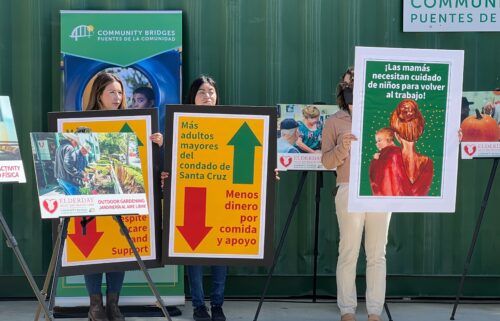The biggest wild card in the climate crisis
By Katie Hunt, CNN
Negative emissions. Carbon capture. Net zero.
It can be daunting, and a little exhausting, keeping up with the terminology from the annual UN climate talks, known as COP27, which are taking place in Sharm el-Sheikh, Egypt.
But CNN’s coverage can help you understand what’s at stake, what action needs to be taken and demystify the technical lingo.
Plus, we take a deeper look at an overlooked driver of climate crisis: the thawing permafrost.
Mission critical
I first became interested in permafrost — the layer of frozen ground beneath the Arctic tundra and high-latitude boreal forests — two years ago when reporting about mysterious holes that had suddenly appeared in remote parts of Siberia.
The craters are perhaps the most extreme example of the dramatic changes happening in the northernmost reaches of the planet as polar regions warm four times faster than the global average.
Permafrost is a particularly unpredictable wild card in the climate crisis. The carbon-storing frozen earth may already be emitting as much greenhouse gas as a country with a large carbon footprint, such as Japan.
Scientists particularly fear “abrupt thaw” that is exposing deeper layers of permafrost and has the power to shock the landscape into releasing more carbon.
Going green
Many are doing their best to minimize a personal role in climate change. But how about going green in death?
Recompose, the first human composting company in the United States, has converted more than 200 corpses into soil and has more than 1,100 people signed up for its prearrangement program.
Demand is likely to grow: California just became the fifth US state to sign a human composting bill into law, and others are considering similar legislation.
Advocates hope it can help slow the climate crisis, with cremations requiring lots of fuel. Carbon emissions from cremating one corpse is the equivalent of driving 470 miles (756 kilometers) in a car, according to one estimate. However, the industry is still new, and there is little research on how much better human composting is for the environment compared with traditional burials.
Want more ideas on how to tackle the climate crisis and reduce your eco-anxiety? Sign up for CNN’s Life, But Greener limited newsletter series.
Explorations
Denmark is home to what’s thought to be the world’s largest collection of brains — a cache of 9,479 of them. It’s a valuable resource for brain research on conditions such as dementia and depression, but one with a dark and controversial history.
The brains belonged to psychiatric patients in Denmark who died between 1945 and 1982 and did not consent to the organ donation. One of the specimens belonged to Kirsten Abildtrup, the great-aunt of journalist Lise Søgaard. Søgaard remembers a picture of Kirsten as a little girl on her grandmother’s wall. No one ever spoke about the child in the photo.
In a quest to understand what happened to her great-aunt, Søgaard discovered her relative’s brain in the collection, now housed in a basement at the University of Southern Denmark in Odense. Kirsten had died at age 24 while being treated for schizophrenia after having a lobotomy a year earlier.
By sharing her family’s story last year in a Danish newspaper, Søgaard has sought to break some of the stigma surrounding mental illness.
Ocean secrets
An expedition to the wreck of the Titanic has led to a surprising discovery.
Divers encountered a rocky reef, made up of volcanic formations, and teeming with lobsters, deep-sea fish, sponges and several species of coral that could be thousands of years old.
The location was earmarked for investigation after Titanic diver P.H. Nargeolet detected a sonar blip in 1996. The veteran submersible pilot initially had thought the anomaly, picked up on echo sounding equipment, might be another shipwreck.
Meanwhile, explorers searching in the Atlantic Ocean for World War II artifacts uncovered debris from the Space Shuttle Challenger, which exploded shortly after takeoff in 1986.
Dig this
The oldest known sentence written in an alphabet has been found in an unexpected place — a lice comb.
The 3,700-year-old ivory comb was unearthed in 2016 during a dig at an Israeli archaeological site called Lachish, but an inscription on the comb wasn’t discovered until five years later. A smartphone snapshot revealed 17 letters that form seven words in Canaanite — the first known alphabet and the source of the one we use to write the English language in today.
The comb is a wonderfully human portal into the past, and the inscription captures a sentiment familiar to anyone unlucky enough to have encountered the pesky critters.
The wonder
Make time for these remarkable reads:
— An exciting medical breakthrough could soon make a difference for people with rare blood types, sickle cell disease or those with certain genetic disorders.
— One of nature’s great mysteries may now have an answer, according to a new study on “fairy circles” in the Namib Desert.
— Octopuses have been caught on video deliberately throwing silt and shells at each other. It could be another example of their humanlike behavior.
— Here’s what the latest image from the James Webb Space Telescope has to do with Taylor Swift’s new song “Bejeweled.”
The-CNN-Wire
™ & © 2022 Cable News Network, Inc., a Warner Bros. Discovery Company. All rights reserved.
Like what you’ve read? Oh, but there’s more. Sign up here to receive in your inbox the next edition of Wonder Theory, brought to you by CNN Space and Science writers Ashley Strickland and Katie Hunt. They find wonder in planets beyond our solar system and discoveries from the ancient world.



